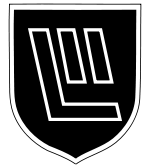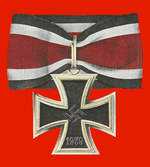Nikolajs Galdiņš
| Nikolajs Galdiņš | |
|---|---|
 SS-Obersturmbannführer Nikolajs Galdiņš | |
| Born |
9 October 1902 Riga, Latvia |
| Died |
5 October 1945 (aged 42) Leningrad, Soviet Union |
| Allegiance |
Latvia Nazi Germany |
| Service/branch |
Latvian Army |
| Years of service |
1919–40 1942–45 |
| Rank | Obersturmbannführer |
| Unit |
|
| Commands held | 42nd Waffen Grenadier Regiment |
| Battles/wars | World War II |
| Awards |
Knight's Cross of the Iron Cross Iron Cross I Class Iron Cross II Class Close Combat Clasp Infantry Assault Badge Wound Badge German Cross in Gold |
Nikolajs Galdiņš (9 October 1902 – 5 October 1945) was an Obersturmbannführer (lieutenant Colonel) in the Waffen SS during World War II. He was awarded the Knight's Cross of the Iron Cross, which was awarded to recognize extreme battlefield bravery or successful military leadership by Nazi Germany during World War II.
Early life
Nikolajs Galdiņš was born on the 9 October 1902 in Riga, Latvia. After World War I he volunteered to join the Latvian Army in July 1919. By 1924 he has graduated from the War Academy and was assigned to the 4th Valmiera Infantry Regiment. He later served on the General Staff as a Captain until 1938, when he was a Military instructor at the 2nd Riga High School.[1]
World War II
During World War II the Latvian Army was abolished in 1940, Galdins for a short time served as an officer in the 195th Rifle Regiment, 181st Division. After the German attack on the Soviet Union (Operation Barbarossa), he volunteered in October 1942, to join the Waffen SS in the Administration department. In the summer of 1943, Galdins was appointed the Adjutant 42nd Waffen Grenadier Regiment, 19th Waffen Grenadier Division of the SS (2nd Latvian), commanded by Voldemars Veiss and served on the Leningrad front. In October 1943, he was given command of the III. Battalion, 42nd Waffen Grenadier Regiment and took over command of the Regiment in January 1944. In October 1944, he was awarded the German Cross in Gold and the Knight's Cross in January 1945 for his bravery and leadership of his Regiment during the fighting in the Kurland Pocket. After the German surrender in May 1945, he was a captive of the Soviet Union and executed by firing squad in Leningrad on the 5 October 1945.[1][2]
Miscellaneous
The Latvian Legion's attachment to the SS, unit designations and ranks were considered a formality. Latvian and Estonian soldiers regardless of whether they volunteered or were drafted, were not members of the Nazi party.
In 1949-50, United States Displaced Persons Commission investigated the Estonian and Latvian "SS" and found these military units to be neither criminal nor Nazi collaborators. On 12 September 1950, Harry N. Rosenfield, the United Nations Refugee Relief Association commissioner, wrote to Jūlijs Feldmanis, Latvia's chargé d'affaires in Washington, saying that «the Waffen-SS units of the Baltic States (the Baltic Legions) are to be seen as units that stood apart and were different from the German SS in terms of goals, ideologies, operations and constitution, and the Commission does not, therefore, consider them to be a movement that is hostile to the government of the United States under Section 13 of the Displaced Persons Act, as amended.»
References
Further reading
- Fellgiebel, Walther-Peer (2000). Die Träger des Ritterkreuzes des Eisernen Kreuzes 1939–1945 – Die Inhaber der höchsten Auszeichnung des Zweiten Weltkrieges aller Wehrmachtteile [The Bearers of the Knight's Cross of the Iron Cross 1939–1945 — The Owners of the Highest Award of the Second World War of all Wehrmacht Branches] (in German). Friedberg, Germany: Podzun-Pallas. ISBN 978-3-7909-0284-6.
- Fey, Will; Henschler, Henri (2003). Armor Battles of the Waffen-SS. Mechanicsburg, PA: Stackpole Books. ISBN 978-0-8117-2905-5.
- Mitcham, Samuel W (2007) [2000]. Retreat to the Reich : the German defeat in France, 1944. Mechanicsburg, PA: Stackpole Books. ISBN 978-0-8117-3384-7.
- Mitcham, Samuel W (2007). The German Defeat in the East, 1944–45. Mechanicsburg, PA: Stackpole Books. ISBN 978-0-8117-3371-7.
| ||||||||||||||||||||||||||||
| ||||||||||


